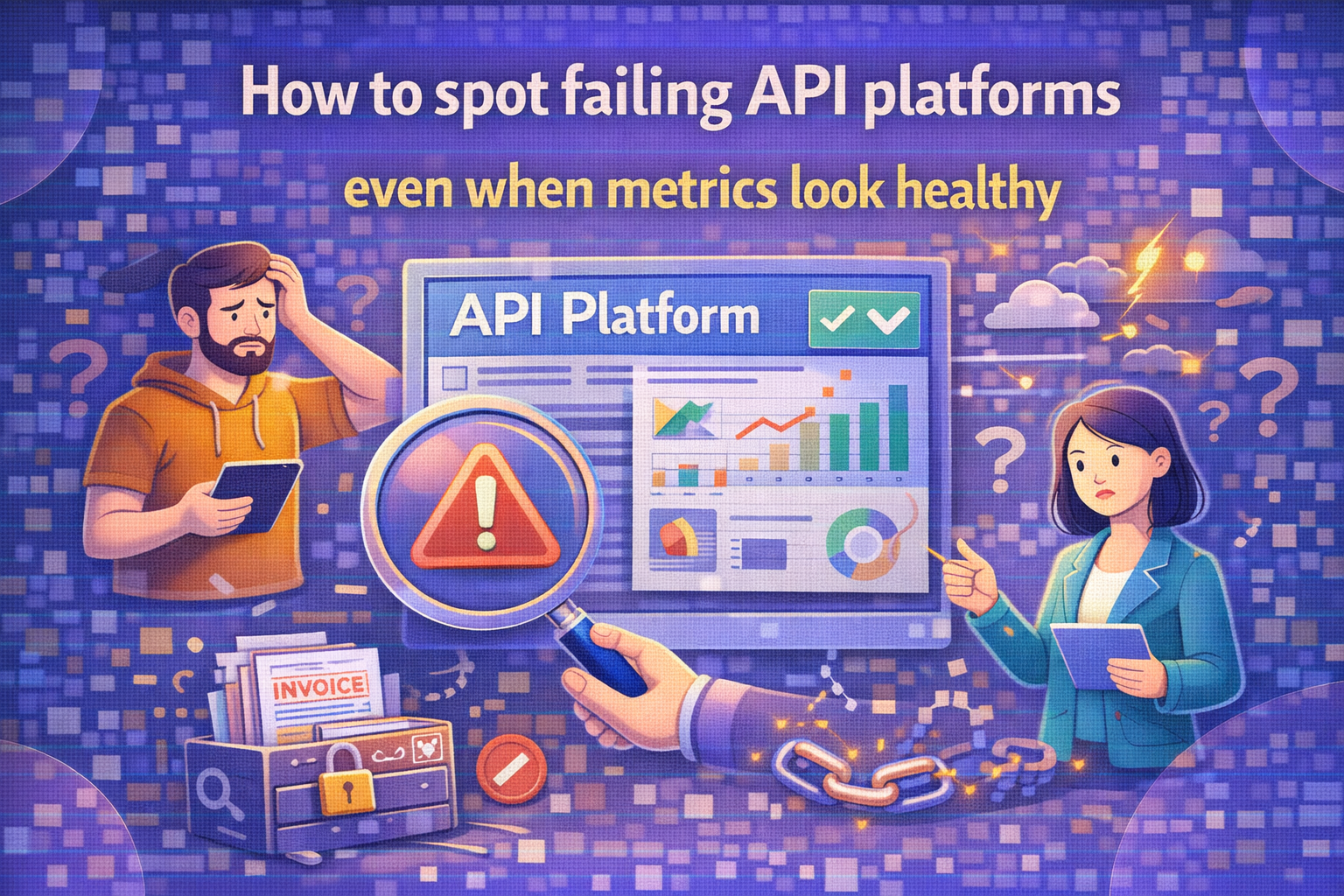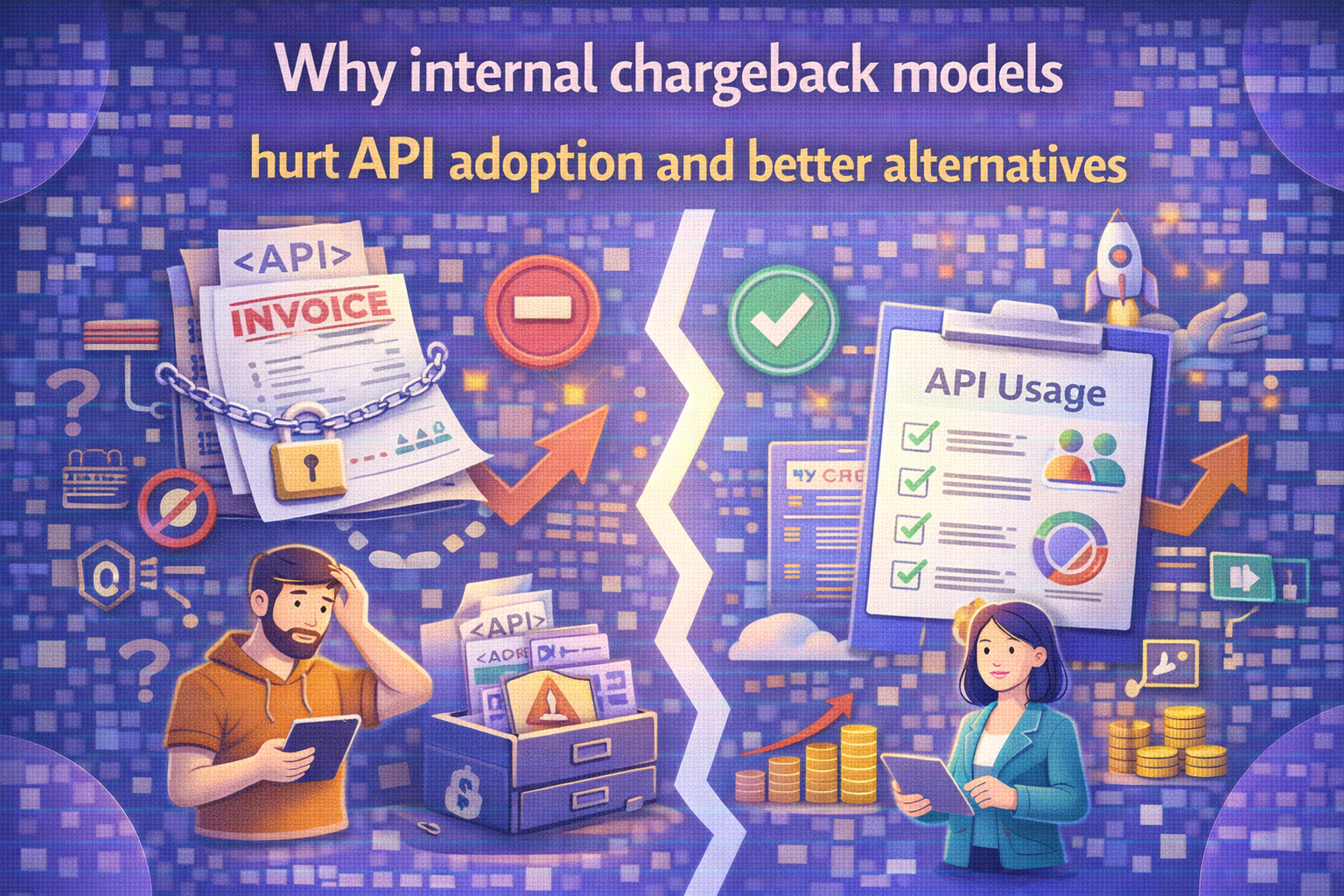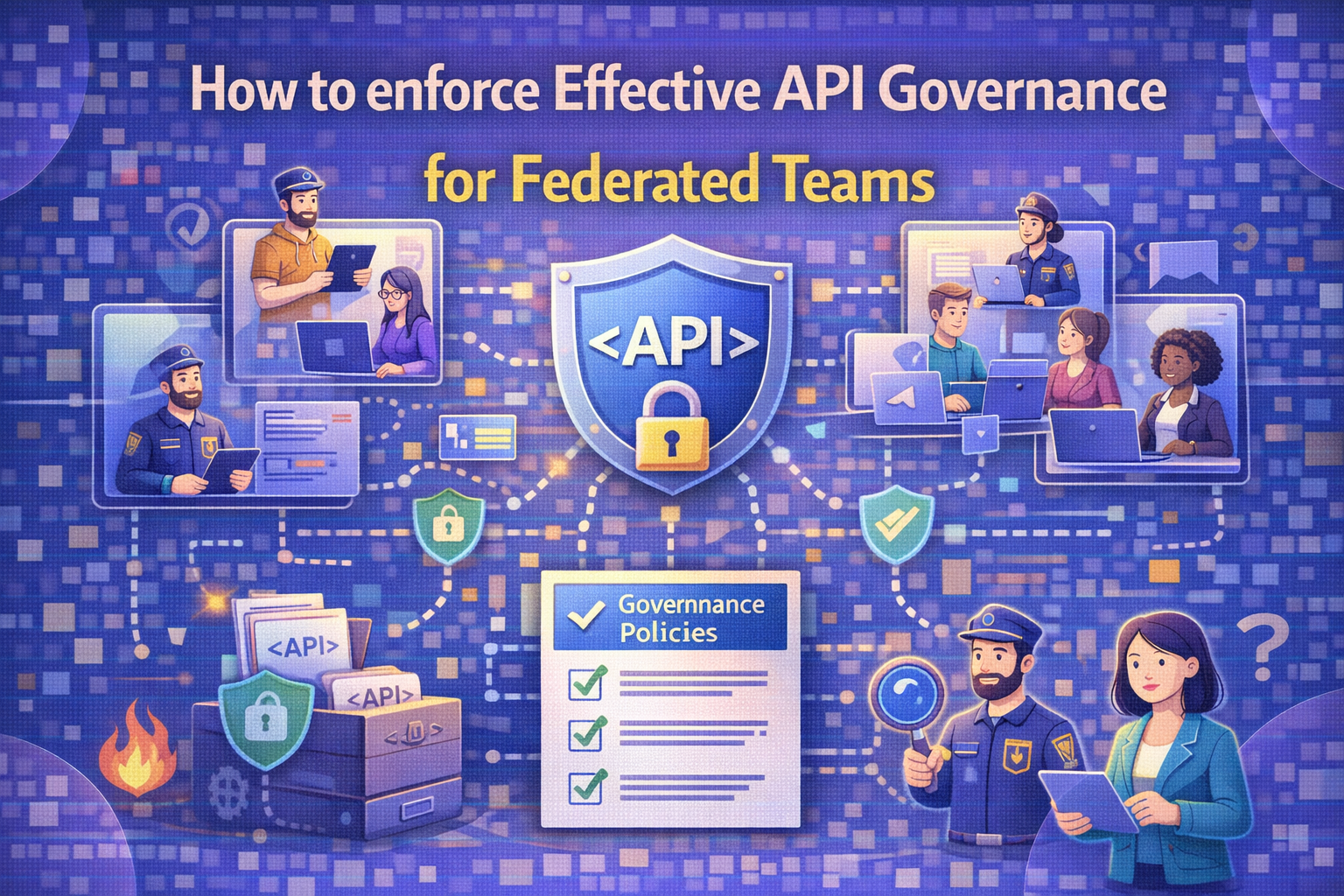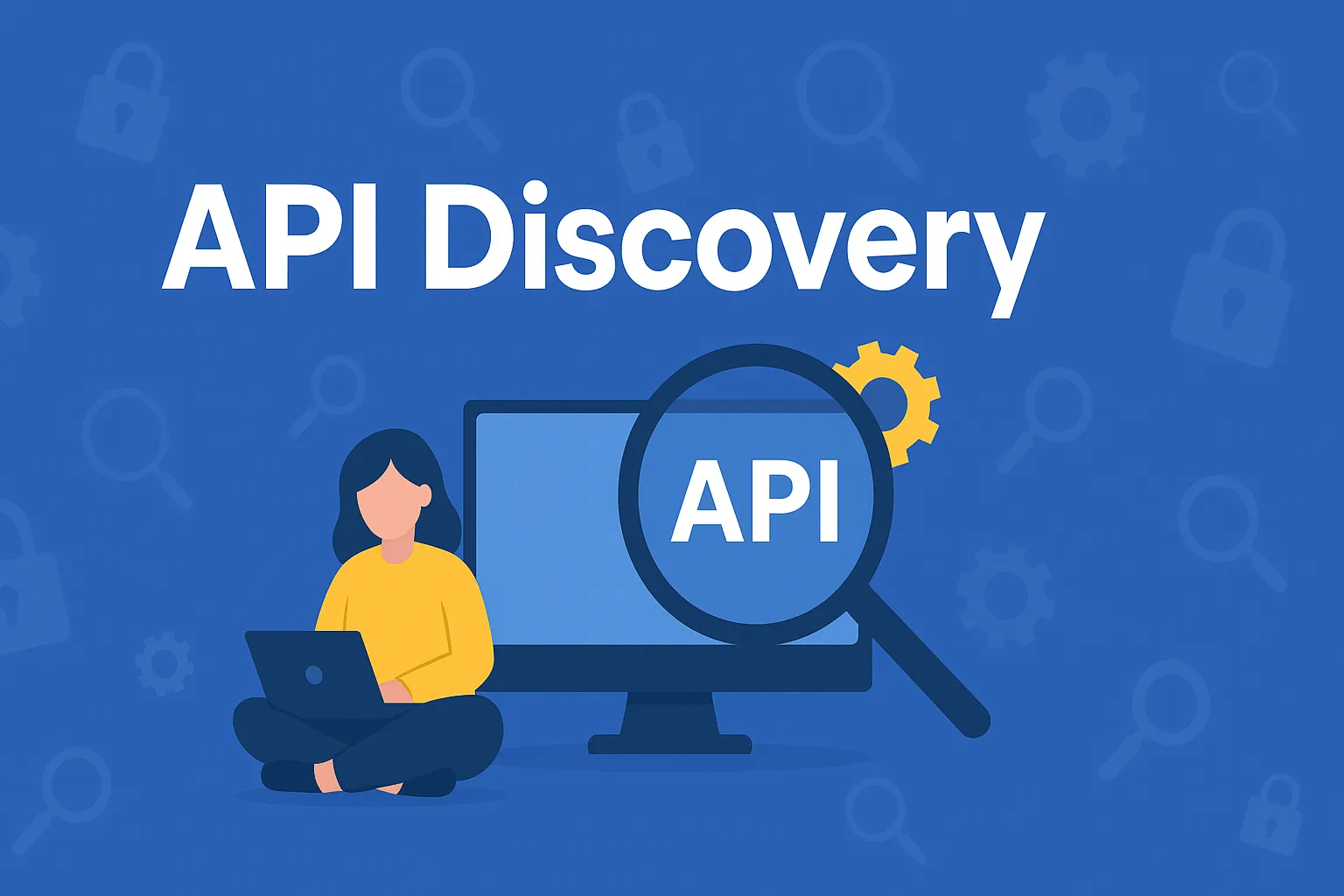
You use APIs to connect the tools and services your business runs on. They help your apps talk to each other, share data, and stay in sync. But as your systems scale, visibility takes a hit. One API gets added, then another, and before you know it, there are pieces running in the background that no one’s watching.
That’s where the risk creeps in. In 2022, API-related breaches cost U.S. companies up to $23 billion, not because the APIs were faulty but because no one saw them coming. You can’t secure what you don’t know exists. This is why API discovery matters. It helps you see what’s in use, what’s exposed, and what needs attention so you can stay ahead of problems.
Key takeaways
- API discovery helps you find every API in your system. It shows you what’s running, where it’s running, and what it’s doing.
- When you know what’s already there, your team works faster. You don’t build things twice or waste time looking for answers.
- You can track how your APIs are being used. That helps you spot problems early and make smart decisions.
- When something breaks, you don’t have to guess what caused it. You already know where everything is.
- Removing unused APIs makes your system safer. Fewer APIs mean fewer chances for something to go wrong.
- Reusing existing APIs saves time and keeps your projects simple. Your team can focus on building, not fixing.
What is API discovery?
API discovery is the process of finding and identifying available APIs within an organization or from external sources. It helps developers locate reusable APIs through catalogs, documentation, or automated tools. Effective API discovery speeds up development, reduces duplication, and improves integration efficiency.
APIs help your apps work together. They let developers add features without building everything from scratch. If your app connects to a map, takes payments, or signs in with Google, it’s using an API. But here’s the thing. The more APIs you have, the more things you have to manage.
One small change or a forgotten connection can break something important. And most people don’t know exactly how many APIs are in their system. That’s why API discovery matters. Once you know what you're dealing with, you can fix what’s broken, protect what matters, and clean up the rest.
Why is API discovery important?
API discovery is important for businesses because it helps them understand their APIs, improve security, and assist in maintaining API documentation. It also helps organisations to find shadow and rogue APIs to protect them from security vulnerabilities.
Here's a more detailed look at why API discovery is important:
1. Faster development
When your team knows what APIs already exist, they stop rebuilding the same functionality, and there’s less duplication of efforts. Discovery gives developers a clear view of what they can reuse, saving time and effort. That means fewer delays, cleaner handoffs, and faster delivery across projects.
2. Easy access to services
Need to add maps, payments, or user authorisation? API discovery helps you find the tools you’re already using. Instead of starting from scratch, your team can plug into trusted services in a few steps. It keeps your apps lightweight and your team focused on what matters most.
3. Better system compatibility
Modern systems are made of many moving parts, often built by different teams at different times. API discovery shows you how those parts are connected and what standards they follow. This makes it easier to add new tools without breaking what’s already working.
4. Shadow API identification
A shadow API refers to an API that’s in use but hasn’t been officially tracked, managed, or secured by your organisation. And it’s very risky for your organisation to have APIs that your team has no information about. API discovery helps you find those hidden or untracked APIs before they become a problem.
5. Better control
It’s hard to manage what you can’t see. Discovery brings visibility to every API you rely on. It enables you to track usage, assign ownership, and clean up what’s no longer needed. That control helps your systems scale without becoming unmanageable.
How API discovery works?
API discovery helps you find and keep track of all the APIs in your system, whether you do it manually or use automated tools. It gives you a full picture of active and dormant APIs so you can manage and secure them better.
Here’s how API discovery works, step by step:
1. Scanning code repositories
Discovery begins by looking at your codebase. It scans through your repositories such as GitHub, GitLab, Bitbucket, or wherever your team works. It looks for any defined endpoints, API calls, or references to external services. Even if an API was added a year ago and never documented, discovery picks it up.
Even if an API was added a year ago and never documented, discovery picks it up. You don’t need a clean system for this to work. The tool reads the code itself, not the documentation. That means you get a complete baseline, including the endpoints your team may have forgotten about.
When you're working across several services, this gives you clarity. You know what’s running, where it lives, and what it connects to before you start planning anything new.
2. Monitoring network traffic
Once the code scan is complete, discovery begins listening to traffic. It watches how services interact in real time. Every API call moving across your infrastructure, whether between internal services or out to a third party, gets tracked.
This is where it uncovers hidden or “shadow” APIs. These are live, functioning endpoints that were never registered, reviewed, or tracked. They often start out as quick fixes or workarounds, but over time, they become permanent parts of your system.
Discovery helps you find them before they cause problems. It’s not just about visibility but also about knowing what’s actually being used in production.
3. Connecting to API gateways
If your team uses tools like AWS API Gateway, Apigee, Kong, or Azure API Management, discovery connects with them directly. It pulls logs, traffic data, metadata, and configuration settings into one place. You don’t have to change how you work or plug into a new platform.
This lets you see which APIs are in production, how often they’re being called, and what rules they follow. And you’ll get to know who’s using this? When was it last updated? Is it following your internal security standards?
The best part is that it happens in the background, without creating more manual work for your team.
4. Cataloging APIs
After collecting data from your code, traffic, and tools, API discovery organises everything into a single catalogue. This isn’t just a spreadsheet but a live, searchable system. Each API includes important details like endpoint paths, supported methods, version history, data formats, usage levels, and ownership, if available.
You can search for it before starting a new project. You can see if another team has already built something similar. Architects can use it to map out systems. Security can monitor what’s exposed.
5. Identifying security gaps
API Discovery doesn’t just list what exists; it tells you what needs your attention. It flags unsecured APIs, outdated versions, missing authentication, and endpoints that are unintentionally public. These are often the areas attackers look for first.
Many of the APIs that show up during discovery were never reviewed or tracked properly. That makes them easy to miss and easy to exploit. Discovery helps you fix those issues before they become critical. You don’t need to be in the middle of an incident to know what’s vulnerable.
6. Updating in real time
Discovery tools don’t run once and stop. They keep monitoring in the background. As new APIs are added or changed, your catalogue updates automatically. You never have to rely on someone remembering to update documentation manually.
It matters when teams move fast. Changes happen daily, and missing even one endpoint can create confusion or risk. With API discovery, your view stays accurate, no matter how quickly your environment shifts. It’s like having a real-time map of your system that updates itself while you work.
7. Supporting better collaboration
When developers, architects, and security teams work from the same API catalogue, they stop stepping on each other’s toes. Developers reuse what exists, security sees what matters and architects design with a full understanding of the current setup.
You don’t waste time asking where things are or whether an API is still in use. You use that knowledge to build smarter and move faster.
Challenges in API discovery
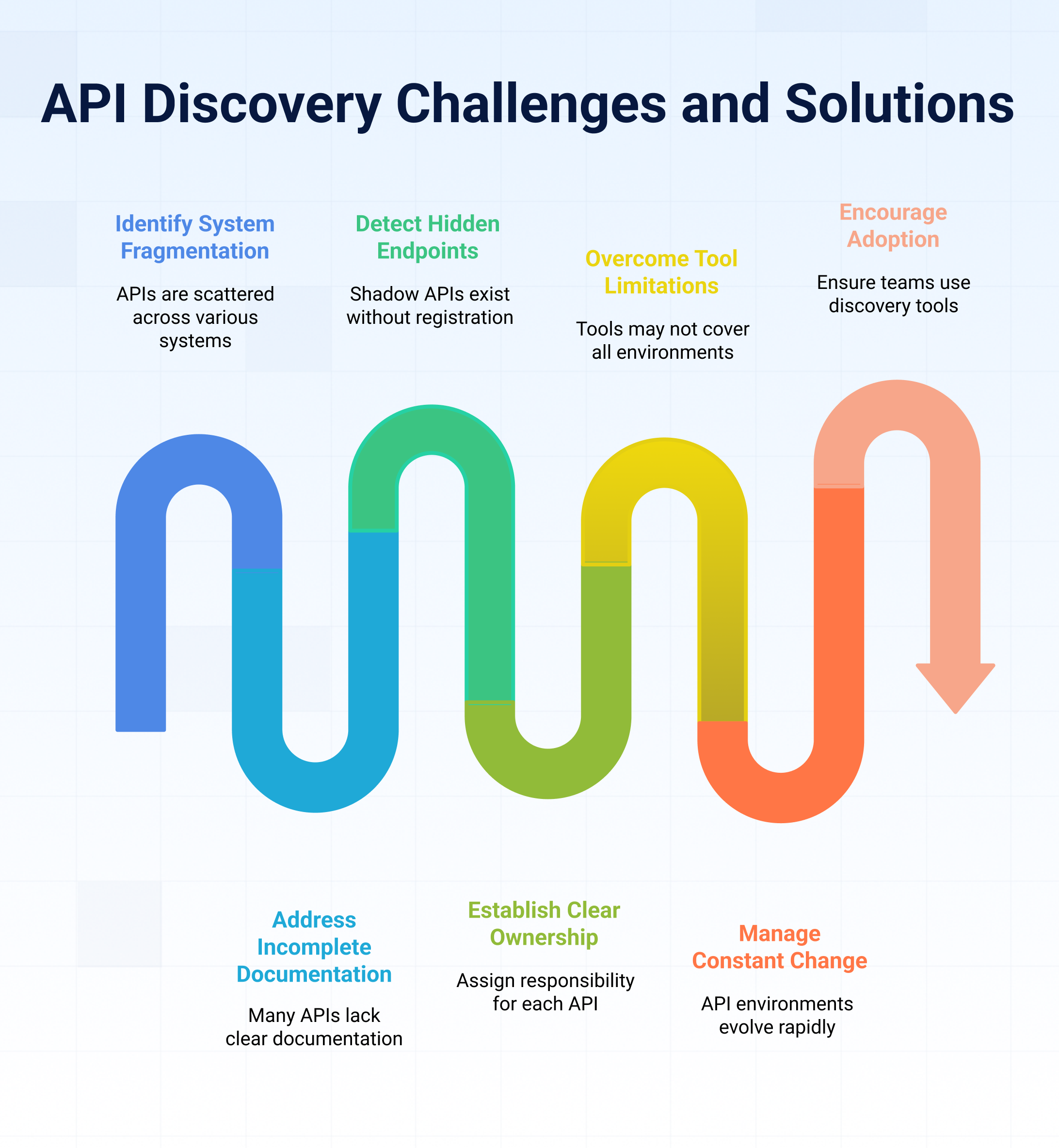
API discovery faces challenges due to decentralised API locations, constantly evolving systems, and the difficulty of managing APIs that are scattered or undocumented. These issues can introduce security risks, slow down development, and make it harder to control how APIs are used.
Below are the key challenges in API discovery:
1. System fragmentation
APIs often live in multiple places across your environment. Some are embedded in your codebase, others sit behind gateways, and a few may run in legacy systems that no one has touched in years. Not to forget the ones that continue working in forgotten test environments.
Because APIs are so spread out, no single tool or team sees the full picture. You may need to look across cloud platforms, on-premise systems, and historical repos just to find what’s active. This complexity is the first obstacle to a clean API inventory.
2. Incomplete documentation
Discovering an API is only half the job; understanding it is the other half. Many APIs exist without clear documentation. You might not know what they do, how they’re used, or whether anyone still relies on them. In fast-paced teams, documentation is often skipped during sprints and never added later.
You might delete something another team depends on or rebuild functionality that already exists. Your visibility will always have gaps without documentation, even after scanning everything.
3. Hidden endpoints
Shadow APIs are one of the most common issues in modern systems. These are endpoints that were created quickly, often as one-off solutions. They were never registered or reviewed, but they stayed in production. They don’t show up in dashboards. They aren’t secured properly. And no one knows they’re still running.
Discovery can help detect them, but cleaning them up takes real effort. Someone has to trace who built them, confirm if they’re still needed, and decide what to do next.
4. Unclear ownership
Once you find an API, someone needs to be responsible for it. In practice, that’s often where things break down. APIs outlast their original developers, teams restructure, projects change hands, and no one is quite sure who owns what.
When there’s no clear owner, you lose accountability. Updates fall through the cracks. Security reviews get skipped. And when something breaks, no one feels responsible for fixing it.
5. Tool limitations
Not every discovery tool works in every environment. Some platforms are built with cloud-native systems in mind. Others depend on modern gateways or event-driven architectures. But if your setup includes legacy software or a hybrid infrastructure, you might not get full coverage.
You may need to combine tools or supplement them with manual work. It slows down adoption and limits the value of your discovery process.
6. Constant change
API environments change quickly. Teams launch new features, update services, and deprecate old versions all the time. If you run discovery once, it gives you a snapshot. But without continuous monitoring, that snapshot becomes outdated within weeks.
Keeping your catalogue accurate requires a process. Whether it’s automation or regular reviews, discovery only works if you keep it alive. Otherwise, you end up with another source of stale data.
7. Low adoption
Tools alone won’t solve the problem. People need to use them. Teams have to register new APIs, update ownership info, and check the catalogue before building something new. That doesn’t always happen. Everyone’s busy. Habits are hard to change. And unless discovery becomes part of the process, it’s easily ignored.
You need more than visibility to get lasting value. You need buy-in. Adoption is the biggest gap between scanning for APIs and managing them well.
Best practices for effective API discovery
API discovery works best when you support it with the right standards, tools, and communication. By putting a few clear practices in place, you can help your teams find, understand, and manage APIs with far less effort.
Here are five best practices for an effective API discovery process:
Use standard API formats
You should design your APIs using standard specifications like REST, GraphQL, or OpenAPI. These formats help both people and discovery tools understand your APIs faster. They bring consistency to how endpoints are structured, described, and shared across your systems.
When your APIs follow predictable rules, discovery tools can recognise them immediately. They can extract metadata, map out dependencies, and document functionality without extra work. This also makes it easier for other teams to reuse your APIs instead of rebuilding something that already exists.
Add metadata and tags
You should include metadata for every API you build. Metadata tells other teams what an API does, who owns it, what version it’s on, and whether it’s public or private. You can also use tags to group APIs by team, product, or use case.
When you add metadata and tagging early, you make discovery easier later. Your tools can sort and filter APIs based on their tags. Your teammates can search by category or purpose. And your security teams can spot exposed or underused APIs more quickly.
Create and follow governance rules
You should define clear rules for how your team builds and manages APIs. Governance helps you stay consistent across teams and projects. It sets expectations for naming, documentation, version control, and security reviews.
When you follow strong governance, you avoid chaos. You reduce the number of shadow APIs. You give every new endpoint a clear owner and a clear place in your system. And you make API discovery faster because everything is easier to track.
Use gateways and management tools
You should connect your APIs through a gateway and track them with a management platform. The gateway helps you control how your APIs are accessed. It can handle security, rate limits, and routing. The management tool helps you track performance, log usage, and maintain documentation.
When you use these tools together, you improve visibility and reduce risk. You don’t just find APIs; you understand how they work, who uses them, and whether they follow your standards. That context makes discovery meaningful, not just technical.
Keep teams in sync
You should make API discovery part of how your teams work together. Developers, platform engineers, and security teams all play a role in creating and managing APIs. API discovery becomes easier when teams stay aligned.
Developers update the catalogue when they ship something new. Security teams get visibility into what’s running. Platform teams can plan without surprises. That shared knowledge turns discovery into a habit — not a cleanup task.
Leverage API discovery to its fullest potential with DigitalAPI
You’ve seen that API discovery isn’t just about spotting endpoints. It’s about getting clarity across systems, cleaning things up, and helping your teams work without guesswork. However, finding the APIs is only part of the job. What happens next matters just as much.
That’s where DigitalAPI comes in. It helps you take everything you’ve discovered and actually put it to work. You can organise your APIs, apply governance, and make them easier for your teams to use or even publish. With tools like the DigitalAPI Service Hub and API Marketplace, you can bring your API strategy to life in one place.
If you want more than visibility and you’re ready to build on it, DigitalAPI is a solid place to start.
Frequently asked questions
1. What’s the difference between API discovery and API documentation?
The main difference between API discovery and API documentation is that API discovery focuses on locating available APIs, while API documentation explains how to use them. Discovery helps developers find APIs through catalogs or registries, whereas documentation provides details like endpoints, parameters, and usage examples.
2. How can I implement an API discovery mechanism in my company?
Implement an API discovery mechanism by creating a centralized API catalog, tagging APIs with metadata, and integrating search functionality. Use tools like DigitalAPI to document APIs and enable visibility. Automate API registration through CI/CD pipelines to ensure newly built APIs are discoverable instantly.
3. How do I make my APIs more discoverable for internal teams?
Make your APIs more discoverable for internal teams by creating a searchable API portal, tagging APIs with clear metadata, and keeping documentation up to date. Integrate API registration into development workflows and use internal tools like wikis, dashboards, or developer portals for visibility.
4. What metadata should I include to improve API discoverability?
Improve API discoverability by including metadata such as API name, version, owner, description, tags, endpoints, authentication type, and usage status. Clear and consistent metadata helps teams quickly understand API purpose, integration points, and current availability, making APIs easier to search and adopt internally.
5. How can I control access while enabling API discovery?
Control access while enabling API discovery by implementing role-based permissions, token-based authentication, and visibility tiers. Restrict sensitive APIs to authorized roles and expose only metadata for public browsing. Use API gateways and identity providers to enforce access policies without blocking discovery.
You’ve spent years battling your API problem. Give us 60 minutes to show you the solution.
.svg)

%20(1).png)

